三陸鉄道開業(1984.4.1)
第三セクター
 今でこそ第三セクターという言葉は、ローカル鉄道や地域の温泉施設を運営する官民共同出資の形態として定着しています。しかし、この言葉を一般に認知させたのがこの三陸鉄道である・・・と言っても、決して過言ではありません。
今でこそ第三セクターという言葉は、ローカル鉄道や地域の温泉施設を運営する官民共同出資の形態として定着しています。しかし、この言葉を一般に認知させたのがこの三陸鉄道である・・・と言っても、決して過言ではありません。それと同時に、その後の第三セクター鉄道の形を確立したという面でも、三陸鉄道の功績は大きいといえるでしょう。
地域との複合機能を持つ駅、国鉄時代より便利になった運行形態、斜めの直線を展開させた奇抜なデザインの車両、いずれも三陸鉄道が先駆けとなりました。
この鉄道は、国鉄再建法で廃止となる国鉄盛(さかり)線(盛〜吉浜)と未成線の吉浜〜釜石間を含めて開通した南リアス線と、同じく国鉄宮古線(宮古〜田老)と久慈線(普代〜久慈)とその間の未成線を含めて開通した北リアス線の2路線から成立しています。南リアス線と北リアス線の間には国鉄山田線がありますが、この三陸鉄道の開業によって、三陸沿岸は宮城県から青森県まで鉄路で結ばれたことになります。
三陸鉄道は沿線悲願の鉄道として、交通の便の悪かった三陸沿岸に大きな期待をもって迎えられました。
テープカット
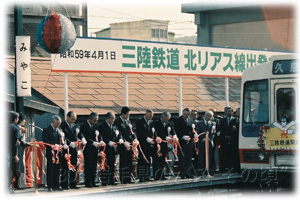
撮影:宮古駅(1984.4.1)
宮古駅で出発式が行われました。
写真は、久慈行の祝賀列車を前にしたテープカットの光景です。小さくて見えにくいですが、中央には鈴木善幸元首相や、当時の仁杉運輸大臣の姿も見えます。
祝賀列車
途中駅でも歓迎ムードで迎えられます。田野畑村の田野畑駅を出て久慈に向かう2両編成の祝賀列車。
三陸鉄道では気動車の新車16両を揃えてスタートしました。軽量構造でこれまでにない斬新なカラーリングを採用、また車内に飲料の自動販売機を備える車両もあります。

撮影:田野畑駅(1984.4.1)
沿線住民に歓迎される各駅の表情
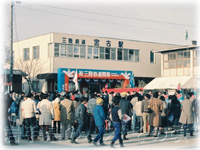
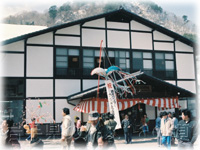
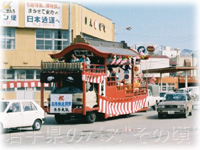
沿線各駅では、アーチが飾られるなど装飾が施され、住民が集まって大きな賑わいを見せていました。
三陸鉄道開業に合わせて建てられた駅舎は、それぞれが趣向を凝らし、また駅名に個性的な副称をつけるなど観光客誘致のための新たな試みが至るところで見られます。
宮古駅は国鉄駅とは離れた場所に建てられ、駅構内には観光案内施設などを備えます。日本家屋風の外観を持つ「カンパネルラ田野畑駅」では、くす玉割が行われていました。2階建てで地元の集会などにも使用できるようになっています。
宮古駅に戻ってきたら、トラックをベースにした山車を見かけました。「魚祭太鼓」と書いてありますが、正面のエプロンには「祝三陸鉄道開業」とあり、三陸鉄道開業を記念したイベントに参加してきたことを物語ります。
その後の三陸鉄道
盛→久慈 三陸縦貫列車
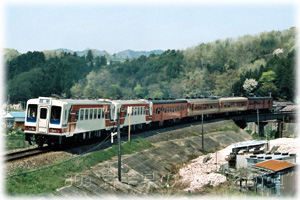
撮影:織笠−陸中山田(1984.5.27)
北リアス線と南リアス線に分断されている三陸鉄道を一つにする試みとして、盛(さかり)から久慈までの団体列車が運行されました。
写真は国鉄山田線で国鉄の列車に併結運転されている光景。
なお、山田線の沿岸区間(宮古−釜石間)の三陸鉄道移管については、一時話の進展が見られたものの、国鉄の民営化により沙汰止みとなりました。
快速「うみねこ号」
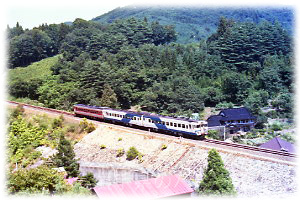
撮影:一の渡−宮古(1984.8.21)
こちらは三陸鉄道に乗入れた国鉄車両です。
東北新幹線に接続し、盛岡から国鉄山田線と三陸鉄道北リアス線を通って久慈までを結ぶ臨時快速列車が運行されました。
車両は、座席のグレードアップを図り、外装デザインを変えた「うみねこカラー」の車両です。
お世話になって3周年
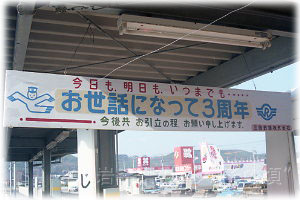
撮影:久慈駅(1987.4.1)
1987年。3周年記念の看板が掲出された久慈駅ホーム。
第三セクターのさきがけとなった三陸鉄道は、様々な経営努力により黒字経営を続け、無事3周年を迎えました。
